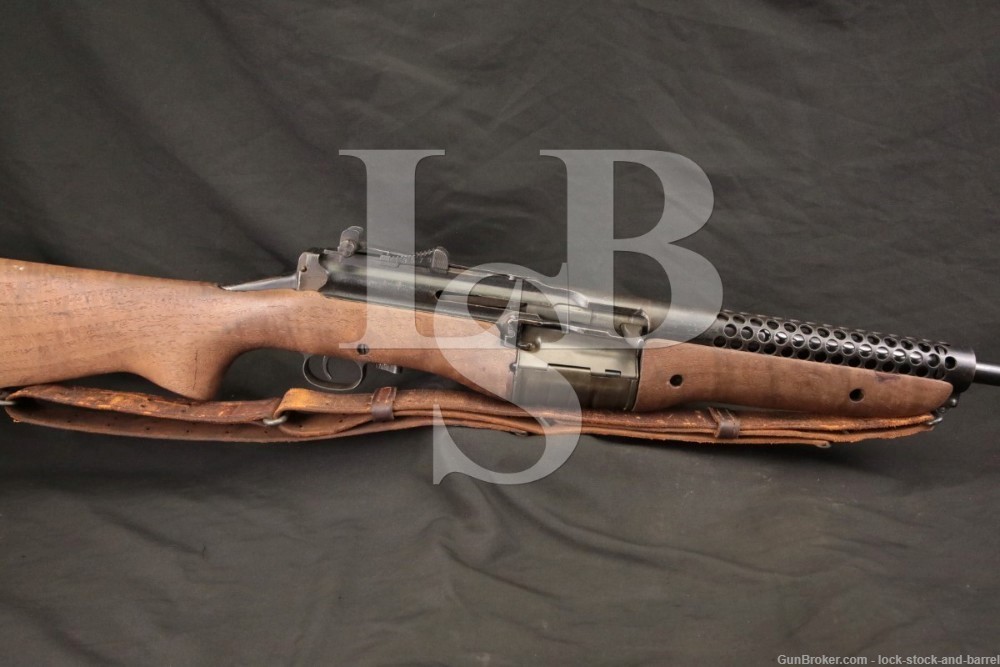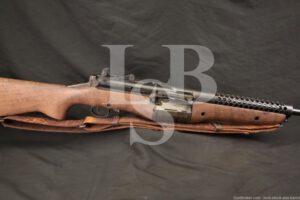
WWII Model 1941 Johnson Automatics – REAL USMC Paratrooper Guadalcanal Used
SOLD FOR: $16025
LSB#: 221006MA001
Make: Johnson Automatics
Model: 1941
Serial Number: 5700
This rifle was used by the U.S. Marine Paratroopers during the initial Solomon Islands campaign. The serial number is specifically listed on page 249 of Bruce Canfield’s book, Johnson Rifles and Machine Guns.
Year of Manufacture: 1941-1942
Caliber: .30-06 Springfield
Action Type: Semi Automatic, 10 Round Internal Rotary Magazine
Markings: The top of the receiver is marked with patent information, the serial number “5700”, “CAL. 30-’06 SEMI AUTO.” and “ ‘JOHNSON AUTOMATICS’ / MODEL OF 1941 / MADE IN PROVIDENCE, R.I., U.S.A.”. The right rear of the receiver is marked “CRANSTON / ARMS / CO” in an inverted “triangle” with a small “star” above it. The “triangle” was a Dutch National symbol and the small “star” is a Dutch acceptance mark (page 251 of Bruce Canfield’s book, Johnson Rifles and Machine Guns). The side of the bolt is marked “8347”. Johnson made no attempt at the factory to use matching part numbers (page 251). The face of the barrel collar is unmarked. The top of the barrel is marked “30-06”. The barrel shank is marked with a few proofs & stamps, “9748” and “BARREL / MADE IN / DENMARK”.
Barrel Length: Approximately 22 Inches
Sights / Optics: The front sight is a post set between two protective ears. The rear sight is a windage adjustable V notched blade set atop an adjustable riser. The rear of the blade is painted white. The adjustment knob functions. The riser is marked “M2” on the left. It is marked “METERS 0-1000” and “1 3 5 7 9” on the right.
Stock Configuration & Condition: The 2 piece wood stock has a pistol grip, several holes for mounting screws, channel under the forearm for the takedown lever, 2 sling loops and a metal buttplate. The hole on the right front of the forearm is a takedown button. It can be pressed with the tip of a bullet to release the barrel takedown lever that is on the bottom front of the forearm. The buttplate shows discoloration from oxidation and areas of surface erosion. The wood shows a few small filled surface repairs. The top of the grip shows a filled and repaired crack. The wood shows several scrapes and scratches. The LOP measures 13 1/2 inches from the front of the trigger to the back of the buttplate. The stock rates in about Very Good condition as refurbished.
Type of Finish: Black Gun Paint
Finish Originality: Refinished Receiver
Bore Condition: The rifle uses a replacement barrel. The grooves near the muzzle are light gray. The remaining grooves are semi bright. There is fouling in the bore which should clean up some. The bore shows an M.E. of -0.8 (negative 0.8).
In this writer’s opinion, this bore rates a 6 out of 10.
Many military and C&R eligible weapons have bores that will show erosion. This is not only due to age but to the fact that corrosive primers were commonly used in ammunition worldwide. For example, the U.S. used corrosive ammunition throughout WWII. The U.S. military did not begin to phase out corrosive-primed ammunition until the 1950’s.
Overall Condition: This rifle retains about 75% of its metal finish. The receiver and barrel shroud have been refinished in black paint. TThey show several scrapes & scratches that have removed areas of the paint finish. The exposed metal shows discoloration from oxidation. The exposed portion of the blue replacement barrel shows surface erosion and discoloration from oxidation. The magazine shows areas of discoloration. The screw heads show use. Most of the markings are well defined. Some of the small markings on the top of the receiver are faded. Overall, this rifle rates in about Very Good condition as refinished.
Mechanics: The action functions correctly. We have not fired this rifle. As with all previously owned firearms, a thorough cleaning may be necessary to meet your maintenance standards.
Box, Paperwork & Accessories: The rifle has a Model 1907 leather sling attached. It is marked “”BOYT / .44.”.
Our Assessment: This is a Rare Johnson Automatics Model 1941 that was used by the U.S. Marine Paratroopers during the initial Solomon Islands campaign. It has since been rebuilt and uses a replacement barrel. Here is some information on this rare WWII rifle from an American Rifleman article written by Bruce Canfield www.americanrifleman.org/content/the-model-of-1941-johnson-rifle-in-marine-service/ :
The standard American service rifle during World War II was the M1 Garand, but the Model of 1941 Johnson was also procured during WWII. The 1941 Johnson is prized by collectors due to its scarcity. The number of Johnson rifles acquired by the United States during the war numbered in the hundreds, it was only issued to a specific U.S. Marine Corps unit, and the rifle was purged from the USMC inventory before the end of World War II.
Melvin Johnson developed a recoil-operated firearm mechanism he believed to be superior to the Garand’s gas-operated system. He was able to persuade the U.S. Army Ordnance Dept. to hold an informal test of his rifle in June 1938. The Johnson rifle performed relatively well in the tests but was not adopted. Johnson turned to other nations in an attempt to market his rifle and light machine gun. Johnson was able to sell his weapons to the Netherlands Purchasing Commission (NPC) who needed to arm the colonial forces in the Dutch East Indies.
In Aug, 1940 the NPC placed an initial contract for Johnson rifles & light machine guns as well as spare parts & accessories. At the time Johnson Automatics did not have the production capabilities to fulfill the contract. Johnson partnered with the Universal Winding Company of Cranston, Rhode Island to form the Cranston Arms Co.; hence the Cranston Arms Co. “triangle” stamping on all Model 1941 Rifles. The “triangle” was a Dutch National symbol.
Not long after the initial shipments of the Johnson rifles and light machine guns left the Rhode Island plant, the East Indies fell to the Japanese and the remaining rifles were embargoed in the United States. Only about 3,000 Johnson rifles had been shipped prior to the embargo.
Johnson barrels can be quickly removed & replaced. This led to some of these embargoed rifles eventually being procured by Marine Parachute battalions. Marine paratrooper Capt. (later Lt. Col.) Harry Torgerson stated that these rifles were used by “select scout-snipers” during the Guadalcanal campaign.
The Johnson rifles issued to Marine Parachute Regiments were standard Dutch-production guns. The limited number of Johnson rifles performed well in combat. One of the more notable achievements was that of Platoon Sgt. Harry M. Tully of the 1st Parachute Battalion. He was awarded a Silver Star when he used his Johnson rifle to kill 42 Japanese on the Solomon Islands at ranges up to 800 yards.
This Model 1941 Rifle is one of the Rare rifles used by the Marine Paratroopers during the Guadalcanal campaign. The rifles were sent to the 1st Marine Parachute Battalion by Melvin Johnson himself, a “loan that turned into a gift”. Of the rifles sent, there are only 23 known, documented examples. The serial number is specifically listed as such on page 249 of Bruce Canfield’s book, Johnson Rifles and Machine Guns. Photos of the book and page are provided below. While trained to be dropped by parachute, the Paramarines were not dropped by parachute into combat with the exception of a small group sent by the OSS to support the French Resistance. The 1st Parachute Battalion was attached to the 1st Marine Division for the invasion of Guadalcanal and seized the small islands of Gavutu and Tanambogo off the Southwest coast of the larger island. The battalion would then join the 1st Marine Raiders for the Tasimboko raid and the Battle of Edson’s Ridge.
The invasion of Guadalcanal, along with Tulagi and Florida (island), represented an important turning point in the war in the Pacific. It was America’s first amphibious invasion of WWII and while it was not the first significant victory in the Pacific, it showed that American forces could retake land previously conquered by the Japanese. There is no telling what this rifle may have seen in its time on Guadalcanal and its small coastal islands. Fighting continued for more than six months before the Japanese finally evacuated the island completely.
This is a rare chance at a rifle which was documented as participating in the invasion of Guadalcanal, made doubly scarce by being a Johnson. There is no telling when such an opportunity may come along again, so don’t miss out on this rifle!
…Now go shoot something!

